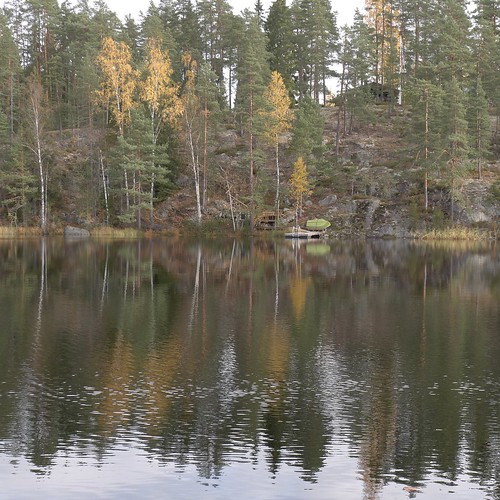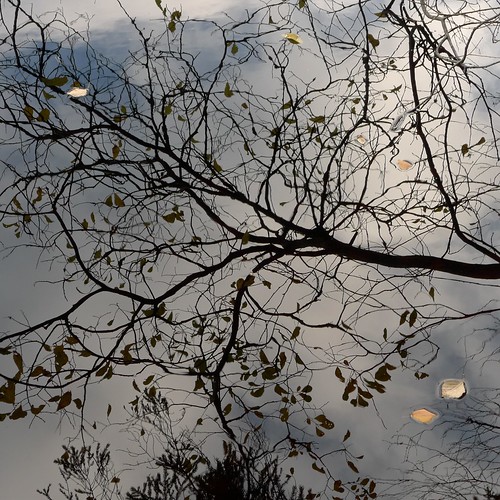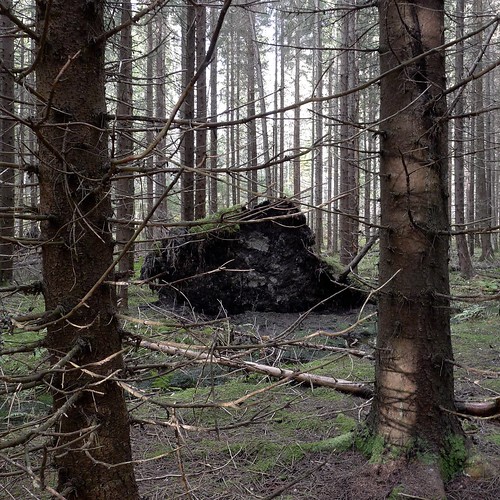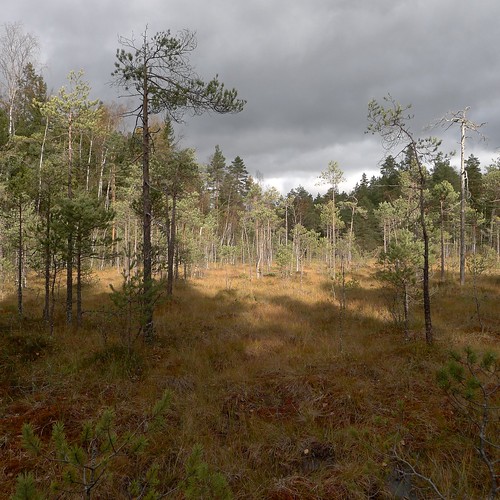In the north part of Luukki forests there is a dagger-shaped area which belongs to the Nuuksio national park, about 1 km wide and 3 km long. On the map is written Ketunkorpi, "Fox swamp", and this is indeed a place which is hard going, as there are no paths, at least in the part which I explored today.
I went to an open swamp which is in the middle of the area, east of Tornikallio, "Tower rock". While almost there I noticed a moose crossing the swamp, behind the trees, about 100 meters in front of me. I think the moose had heard me. It kept on going, occasionally looking in my direction. Although it didn't run it was really fast. It crossed the swamp in less than a minute, and then it was gone.
I went to the swamp, thinking that I'll cross it where the moose had gone, but it was heavy going, jumping one firm patch to another, trying not to step on the less firm parts of the swamp. It took me 15 minutes to cross the swamp.
While returning from the swamp, I thought about a guide on photography. I have been reading - or browsing - Tom Ang's book Digital Photography Step by Step (Dorling Kindersley, 2011).
This is a massive book, but it has the typical problem of photography books these days: topics are split into lists and short pieces, without longer explanations, just tidbits.
"Step by step", I think this is the idea, but I don't like it.
One aspect of the book is recipes for those moments when you are not "inspired". Try this, try that, ... Are we really so easily bored and sidetracked that we need to be inspired with recipies?
As another writer put it, you can try the zen attitude only after you are well fed and clothed. Then it is nice to sit with your legs crossed. In other words, maybe we have it too good - would less be more?
Well, at least I should write a bit more about the book.
Ang really knows his stuff, and there are occasional pieces of brilliance in the book, when he gets to explain advanced topics, or when he picks one photograph out of the series and explains why it is the best and what makes the others weaker than his pick.
But still, I wonder do the readers really get the best possible help from this book? The problem is that some topics are only touched very shortly, and you need to know this stuff already to be able to understand the point of the text.
As an example, Ang does explain the difference with software such as Adobe Photoshop and software such as Aperture and Lightroom, which work on a virtual copy of a photograph, not changing the original. But does the reader understand why this is good? (Well, is it good?)
So: the book contains a huge amount of material and topics, some of which is described in some depth, but mostly very shortly, skimming from one thing to another. Is this the way to learn photography?
On the other hand, this skimming is probably the way people nowadays approach any subject on the net, skipping from one topic to another, not going into detail into anything. In a way this book - and almost all guides on photography published nowadays - emulate the user experience of internet. No depth to anything.
But still, I learned a couple of things from the book. I noticed that one of the photographs shown in large size was taken with the Panasonic LX3, namely "Suburban moonrise" on pages 130-131.
Ang had used f/7.1, ISO 400, -0.3 EV, 1/3 s; an interesting mix of LX3 settings. And this photograph works well, demonstrating that Ang really can use a camera, even the LX3: "As always, it's not what you see that creates a photograph, but how you see it."
The book contains almosts anything a beginner's guide to photography should contain, and then some more. There is even a long section on making videos.
Ang uses Photoshop and Aperture in his examples on post-processing, but generalizing, showing the techniques as generic. This is good and bad. On the other hand, the terminology is taken from these programs, so one can find the needed controls there, even though they often are not shown in detail in the book. On the other hand, if you are using some other software, then learning by doing may be a bit more challenging.
Ang's approach allows the reader to approach post-processing from the "why" approach, maybe helping to get away from the "Photoshop will fix this" thinking and think about what is the meaning instead. So, this approach may be pedagogically good even though not as easy as showing detailed screen captures on what to do.
So, in summary: Ang has written a good guide on photography, better than most, and quite massive in scope. But the book is a bit too skimpy for my taste, even though there were flashes of deep understanding in the book. And many of the photographs are excellent, not overdoing saturation or resorting to other gimmicks, which is as it should be.
When are we going home?
2 hours ago











No comments:
Post a Comment